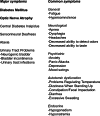Wolfram Syndrome: Diagnosis, Management, and Treatment
- PMID: 26742931
- PMCID: PMC4705145
- DOI: 10.1007/s11892-015-0702-6
Wolfram Syndrome: Diagnosis, Management, and Treatment
Abstract
Wolfram syndrome is a rare genetic disorder characterized by juvenile-onset diabetes mellitus, diabetes insipidus, optic nerve atrophy, hearing loss, and neurodegeneration. Although there are currently no effective treatments that can delay or reverse the progression of Wolfram syndrome, the use of careful clinical monitoring and supportive care can help relieve the suffering of patients and improve their quality of life. The prognosis of this syndrome is currently poor, and many patients die prematurely with severe neurological disabilities, raising the urgency for developing novel treatments for Wolfram syndrome. In this article, we describe natural history and etiology, provide recommendations for diagnosis and clinical management, and introduce new treatments for Wolfram syndrome.
Keywords: Blindness; Deafness; Endoplasmic reticulum stress; Genetic disorder; Neurodegeneration; Type 1 diabetes; Type 2 diabetes; Wolfram syndrome; β cells.
Figures



References
-
- Wolfram DJ, Wagener HP. Diabetes mellitus and simple optic atrophy among siblings: report of four cases. Mayo Clin Proc. 1938;1:715–8.
Publication types
MeSH terms
Grants and funding
LinkOut - more resources
Full Text Sources
Other Literature Sources
Medical

